Kathleen Jones's Blog, page 31
May 26, 2015
Loving Victoria
I'm now in Victoria, at the south end of Vancouver Island and really enjoying this city. The atmosphere is such a contrast to Vancouver - amazing what a difference a ferry ride can make! I was tempted to come by plane, but it's much more expensive than the bus and ferry and you don't see as much. You also meet some interesting people on the ferry - one of my fellow passengers confessed that he was also a writer. And then he told me what he'd written - almost every comedy slot on US TV from Bob Newhart to House and Frasier. Needless to say, he was staying in the nicest hotel in Victoria, while I was off to a budget motel at the other end of town!
A lot of people travel by sea plane here. They're buzzing around the harbour all the time. Quite a few people seem to own them too - some of the local guys in the cafe at breakfast were swapping anecdotes about crashes and near-misses and insurance claims as casually as we'd discuss a couple of scrapes in a supermarket carpark.
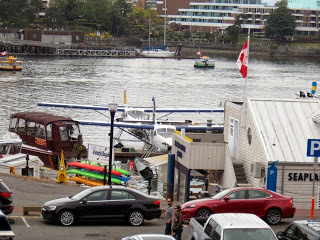
Victoria has fewer high rise developments than Vancouver and it's much greener with more open spaces. There are also more old buildings and quirky streets. I've been enjoying just wandering about.
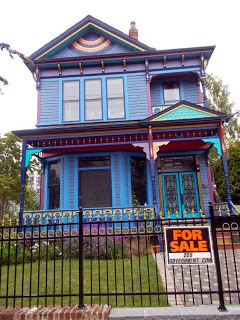 One of Victoria's 'heritage' houses.Down on the docks there's impromptu music - the Irish get everywhere!
One of Victoria's 'heritage' houses.Down on the docks there's impromptu music - the Irish get everywhere!
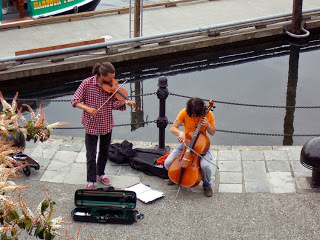
One of the things I've come to see is the Museum of British Columbia and I've just spent several hours there in what is definitely one of the best museums I've ever visited. In the natural history section the first thing that confronts you is a life size Woolly Mammoth that roars at you as you walk through.
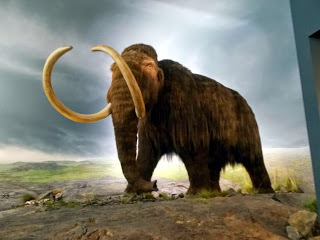 All the displays are 3D - life size and complete with sound effects and smells. The rocks and sand on the beach (and the water!) are all real, plus the driftwood and the stuffed animals.
All the displays are 3D - life size and complete with sound effects and smells. The rocks and sand on the beach (and the water!) are all real, plus the driftwood and the stuffed animals.
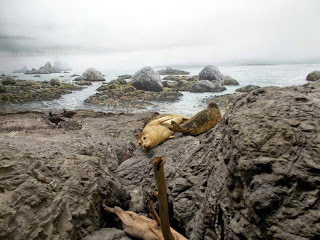
The museum has extensive displays on climate change and what it will mean for Canada. There are maps of the changing ecology. At the moment British Columbia is experiencing extreme dry weather and high temperatures as part of a recurring pattern. Further north there are more than 80 forest fires burning. The museum is trying to educate visitors about the causes of climate change and what human beings can do to mitigate it.
The Parliament building is next door to the Museum and people were demonstrating outside against pollution - many of them First Nation people. They are rapidly putting themselves on the front line in environmental issues, not just in British Columbia, but in Alberta too.
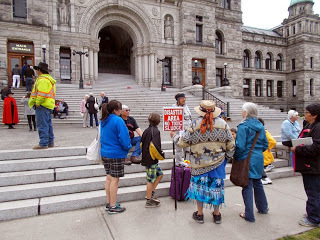
Sadly, Victoria - like Vancouver - has a homeless problem. This was only one of those I saw while walking into town - many of them quite young people, like this girl.
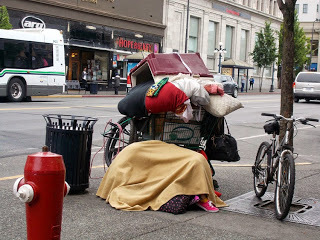 Homeless, but with wheels.I'm going back to the museum tomorrow to visit their 'Living Language' exhibition and extensive collection of First Nation documents and artefacts. There is so much to see. And then I've got to go to Emily Carr's house . . . She once wrote to a friend: ‘Life is like a whole packet of firecrackers going off at once without even waiting for the match’. It certainly is.
Homeless, but with wheels.I'm going back to the museum tomorrow to visit their 'Living Language' exhibition and extensive collection of First Nation documents and artefacts. There is so much to see. And then I've got to go to Emily Carr's house . . . She once wrote to a friend: ‘Life is like a whole packet of firecrackers going off at once without even waiting for the match’. It certainly is.
I'm beginning to love Canada.
A lot of people travel by sea plane here. They're buzzing around the harbour all the time. Quite a few people seem to own them too - some of the local guys in the cafe at breakfast were swapping anecdotes about crashes and near-misses and insurance claims as casually as we'd discuss a couple of scrapes in a supermarket carpark.

Victoria has fewer high rise developments than Vancouver and it's much greener with more open spaces. There are also more old buildings and quirky streets. I've been enjoying just wandering about.
 One of Victoria's 'heritage' houses.Down on the docks there's impromptu music - the Irish get everywhere!
One of Victoria's 'heritage' houses.Down on the docks there's impromptu music - the Irish get everywhere!
One of the things I've come to see is the Museum of British Columbia and I've just spent several hours there in what is definitely one of the best museums I've ever visited. In the natural history section the first thing that confronts you is a life size Woolly Mammoth that roars at you as you walk through.
 All the displays are 3D - life size and complete with sound effects and smells. The rocks and sand on the beach (and the water!) are all real, plus the driftwood and the stuffed animals.
All the displays are 3D - life size and complete with sound effects and smells. The rocks and sand on the beach (and the water!) are all real, plus the driftwood and the stuffed animals.
The museum has extensive displays on climate change and what it will mean for Canada. There are maps of the changing ecology. At the moment British Columbia is experiencing extreme dry weather and high temperatures as part of a recurring pattern. Further north there are more than 80 forest fires burning. The museum is trying to educate visitors about the causes of climate change and what human beings can do to mitigate it.
The Parliament building is next door to the Museum and people were demonstrating outside against pollution - many of them First Nation people. They are rapidly putting themselves on the front line in environmental issues, not just in British Columbia, but in Alberta too.

Sadly, Victoria - like Vancouver - has a homeless problem. This was only one of those I saw while walking into town - many of them quite young people, like this girl.
 Homeless, but with wheels.I'm going back to the museum tomorrow to visit their 'Living Language' exhibition and extensive collection of First Nation documents and artefacts. There is so much to see. And then I've got to go to Emily Carr's house . . . She once wrote to a friend: ‘Life is like a whole packet of firecrackers going off at once without even waiting for the match’. It certainly is.
Homeless, but with wheels.I'm going back to the museum tomorrow to visit their 'Living Language' exhibition and extensive collection of First Nation documents and artefacts. There is so much to see. And then I've got to go to Emily Carr's house . . . She once wrote to a friend: ‘Life is like a whole packet of firecrackers going off at once without even waiting for the match’. It certainly is.I'm beginning to love Canada.
Published on May 26, 2015 22:39
Tuesday Poem: Poetry in Transit - Jennica Harper
Vancouver has a great scheme - posting poems on the buses and the mass transit system. This one is by Canadian poet
Jennica Harper
Fever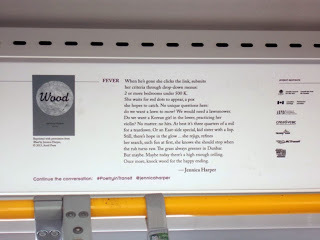
When he's gone she clicks the link, submits
her criteria through drop-down menus
2 or more bedrooms under 500k.
She waits for red dots to appear, a pox
she hopes to catch. No unique questions here:
do we need a lawn to mow? We would need a lawnmower.
Do we want a Korean girl in the lower, practising her
violin? No matter: no hits. At best it's three quarters of a mil
for a teardown. Or an Eastside special, kid sister with a lisp.
Still, there's hope in the glow . . . she rejigs, refines
her search, such fun at first, she knows she should stop when
the rub turns raw. The grass always greener in Dunbar.
But maybe, maybe today there's a high enough ceiling.
Once more, knock wood for the happy ending.
Copyright Jennica Harper , from Wood published by Anvil Press
In 2014 Wood was awarded the Dorothy Livesay Prize for the best book of poetry in British Columbia.
Vancouver - like many big cities - has a crisis in affordable housing. On my first evening here there was a news item lamenting that most of the young people born in 2000 (the Millenials) will have to move away from Vancouver because there is no way that they can afford to live here. Vancouver is a very expensive city for tourists as well as residents and I've witnessed a lot of poverty while I've been here - more people begging or sleeping on the streets than I've seen in London.
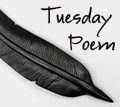 The Tuesday Poets are an international group who try to post a poem every Tuesday and take it in turns to edit the main hub. Please click the link if you'd like to see what other Tuesday Poets are posting.
The Tuesday Poets are an international group who try to post a poem every Tuesday and take it in turns to edit the main hub. Please click the link if you'd like to see what other Tuesday Poets are posting.
Fever

When he's gone she clicks the link, submits
her criteria through drop-down menus
2 or more bedrooms under 500k.
She waits for red dots to appear, a pox
she hopes to catch. No unique questions here:
do we need a lawn to mow? We would need a lawnmower.
Do we want a Korean girl in the lower, practising her
violin? No matter: no hits. At best it's three quarters of a mil
for a teardown. Or an Eastside special, kid sister with a lisp.
Still, there's hope in the glow . . . she rejigs, refines
her search, such fun at first, she knows she should stop when
the rub turns raw. The grass always greener in Dunbar.
But maybe, maybe today there's a high enough ceiling.
Once more, knock wood for the happy ending.
Copyright Jennica Harper , from Wood published by Anvil Press
In 2014 Wood was awarded the Dorothy Livesay Prize for the best book of poetry in British Columbia.
Vancouver - like many big cities - has a crisis in affordable housing. On my first evening here there was a news item lamenting that most of the young people born in 2000 (the Millenials) will have to move away from Vancouver because there is no way that they can afford to live here. Vancouver is a very expensive city for tourists as well as residents and I've witnessed a lot of poverty while I've been here - more people begging or sleeping on the streets than I've seen in London.
 The Tuesday Poets are an international group who try to post a poem every Tuesday and take it in turns to edit the main hub. Please click the link if you'd like to see what other Tuesday Poets are posting.
The Tuesday Poets are an international group who try to post a poem every Tuesday and take it in turns to edit the main hub. Please click the link if you'd like to see what other Tuesday Poets are posting.
Published on May 26, 2015 08:16
May 25, 2015
Vancouver - demonstrations and disappointment
Many people love Vancouver - several have told me it's their favourite city. But not for me. It's too big, too confusing, too expensive. I think you need to know where to go here and you need transport - the distances are just too great on foot. This image sums the city up for me.
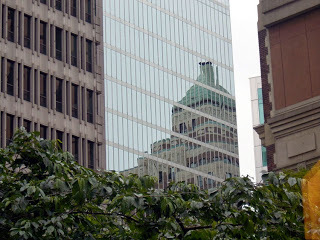
I consoled myself with breakfast in a Chocolate Cafe - about 2000 calories of waffles, cream and Belgian chocolate (best skip over that one!) - and made my way through the steel and glass canyons to find the Vancouver Art Gallery, where I stumbled into a massive demonstration against GM Foods and Monsanto Spraying. Apparently it's a big problem in Canada.
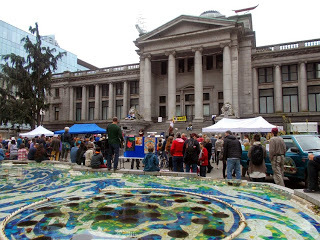
I sat for a while listening to some passionate, very well informed speeches and pledged my whole-hearted support for food that hasn't been poisoned. Even the trucks were non-gmo here!
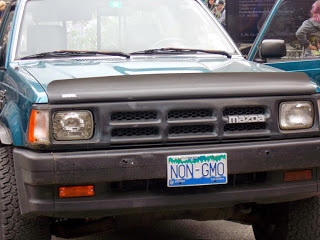
It was a very well-organised, well-behaved demo - children waving balloons, stalls selling food, people picnicking. But the riot police were just around the corner and they didn't like me taking pictures.
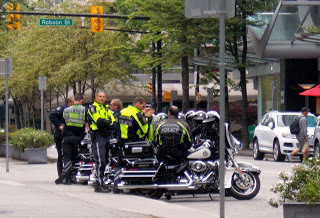
Vancouver Art Gallery has some fantastic collections, so I had high hopes of a pleasant afternoon, but the reality was a big disappointment. The gallery is being totally refurbished - builders everywhere and the 2 lower floors completely empty where the permanent collection is supposed to be. I saw some labels about to go up that suggested Cezanne might eventually be located there and another for a room that would be showing Jacques Lipschitz. But no paintings, just the relentless banging of builders. The third floor had a very thin display of contemporary young Canadian artists and the top floor (which I'd specifically wanted to see) a few tree paintings and drawings by Emily Carr in one small room. And I mean a few. Having been charged the full price for admission, I felt thoroughly cheated.
But what made me very, very, angry, was the fact that the Art Gallery has no work by any Canadian artists, historic or contemporary, who are of indigenous origin. The exhibits are all European art, or Canadian artists working in the European tradition. It's a kind of Art Apartheid. It's OK to have Emily Carr, a European who painted indigenous works of art, but .... You want to see indigenous art? You have to go to the Museum of Anthropology. Or down the road, where a gallery in memory of one of the greatest artists that Canada has ever produced, Bill Reid, is showing work by him and by other indigenous artists. The Bill Reid gallery is a small art-deco gem among the tall buildings and manages to survive the flashing neon sign outside advertising the underground carpark that serves the shopping mall next door.
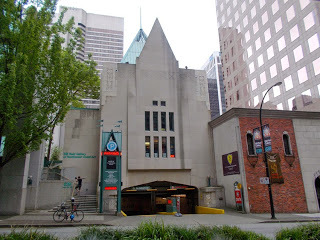
No photographs are allowed, but I saw some beautiful sculpture, paintings, fabric work and jewellery and had a much better time than in the Vancouver Art Gallery. Apparently a new Art Gallery is planned for 2021 which 'will connect the past the present and the future' and display 'a commitment to the diverse communities we live in'. I'm not hanging about in anticipation.
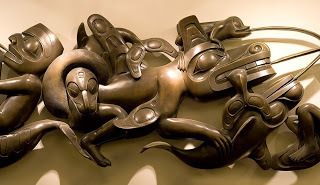 Mythic Messengers - a sculpture illustrating the Haida saying 'Everything is connected'. Bill Reid FoundationTomorrow I'm off to Victoria on the bus and the ferry, to begin exploring Vancouver Island. Victoria is where Emily Carr was born and lived for most of her life, so I'm hoping to be able to see her home.
Mythic Messengers - a sculpture illustrating the Haida saying 'Everything is connected'. Bill Reid FoundationTomorrow I'm off to Victoria on the bus and the ferry, to begin exploring Vancouver Island. Victoria is where Emily Carr was born and lived for most of her life, so I'm hoping to be able to see her home.
Meanwhile - here's a young musician and indigenous activist called Kinnie Starr, making an appeal for the oceans of the world.

I consoled myself with breakfast in a Chocolate Cafe - about 2000 calories of waffles, cream and Belgian chocolate (best skip over that one!) - and made my way through the steel and glass canyons to find the Vancouver Art Gallery, where I stumbled into a massive demonstration against GM Foods and Monsanto Spraying. Apparently it's a big problem in Canada.

I sat for a while listening to some passionate, very well informed speeches and pledged my whole-hearted support for food that hasn't been poisoned. Even the trucks were non-gmo here!

It was a very well-organised, well-behaved demo - children waving balloons, stalls selling food, people picnicking. But the riot police were just around the corner and they didn't like me taking pictures.

Vancouver Art Gallery has some fantastic collections, so I had high hopes of a pleasant afternoon, but the reality was a big disappointment. The gallery is being totally refurbished - builders everywhere and the 2 lower floors completely empty where the permanent collection is supposed to be. I saw some labels about to go up that suggested Cezanne might eventually be located there and another for a room that would be showing Jacques Lipschitz. But no paintings, just the relentless banging of builders. The third floor had a very thin display of contemporary young Canadian artists and the top floor (which I'd specifically wanted to see) a few tree paintings and drawings by Emily Carr in one small room. And I mean a few. Having been charged the full price for admission, I felt thoroughly cheated.
But what made me very, very, angry, was the fact that the Art Gallery has no work by any Canadian artists, historic or contemporary, who are of indigenous origin. The exhibits are all European art, or Canadian artists working in the European tradition. It's a kind of Art Apartheid. It's OK to have Emily Carr, a European who painted indigenous works of art, but .... You want to see indigenous art? You have to go to the Museum of Anthropology. Or down the road, where a gallery in memory of one of the greatest artists that Canada has ever produced, Bill Reid, is showing work by him and by other indigenous artists. The Bill Reid gallery is a small art-deco gem among the tall buildings and manages to survive the flashing neon sign outside advertising the underground carpark that serves the shopping mall next door.

No photographs are allowed, but I saw some beautiful sculpture, paintings, fabric work and jewellery and had a much better time than in the Vancouver Art Gallery. Apparently a new Art Gallery is planned for 2021 which 'will connect the past the present and the future' and display 'a commitment to the diverse communities we live in'. I'm not hanging about in anticipation.
 Mythic Messengers - a sculpture illustrating the Haida saying 'Everything is connected'. Bill Reid FoundationTomorrow I'm off to Victoria on the bus and the ferry, to begin exploring Vancouver Island. Victoria is where Emily Carr was born and lived for most of her life, so I'm hoping to be able to see her home.
Mythic Messengers - a sculpture illustrating the Haida saying 'Everything is connected'. Bill Reid FoundationTomorrow I'm off to Victoria on the bus and the ferry, to begin exploring Vancouver Island. Victoria is where Emily Carr was born and lived for most of her life, so I'm hoping to be able to see her home.Meanwhile - here's a young musician and indigenous activist called Kinnie Starr, making an appeal for the oceans of the world.
Published on May 25, 2015 08:53
May 23, 2015
Vancouver Museum of Anthropology
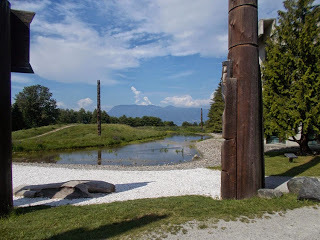
You couldn't invent a better setting for a Museum, on a cliff-top above the Pacific Ocean, with a back drop of mountains and views across the city.
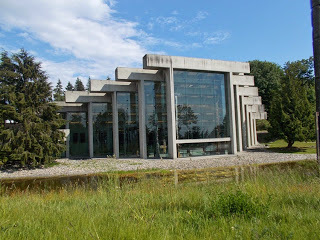
It's a very modern building and the concrete architecture mimics the uprights and cross beams of traditional First Nation 'Big Houses' built by the people of this area (Kwakwaka' Wakw). They have some examples of the originals inside.
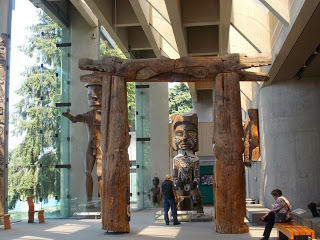
But it was the Haida exhibits I'd come to see and I wasn't disappointed. There are replica canoes and salvaged fragments of the Housepoles from abandoned villages.
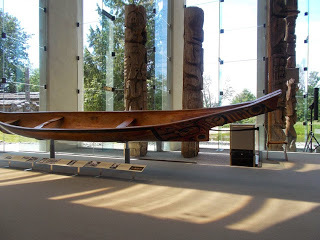
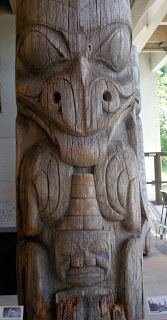
Haida painted chests were also there, with their mysterious 'formlines' which take their ancestral storylines into abstraction. These chests were an important part of Haida life, containing their ceremonial regalia and storing the gifts that would be given away by the chief at the 'Potlatch' feasts. When a chief died, he would sometimes be interred in one of these chests, folded into a foetal position.
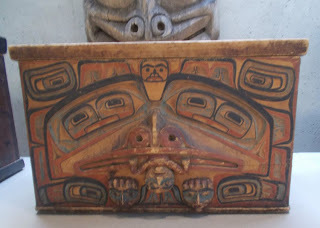
For me, the centrepiece of the museum was the Bill Reid sculpture - carved from a single, gigantic piece of yellow cedar - which features part of the Raven creation myth, when Raven discovers human beings hiding in a clam shell.
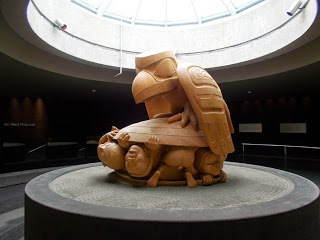
This is Bill Reid's version of the story. Raven has already brought the land that is now Haida Gwaii up out of the sea.
“The great flood, which had covered the earth for so long, had at last receded and the sand of
Rose Spit, Haida Gwaii, lay dry. Raven walked along the sand, eyes and ears alert for any unusual sight or sound to break the monotony. A flash of white caught his eye and there, right at his feet, half buried in the sand, was a gigantic clam shell.
He looked more closely and saw that the shell was full of little creatures cowering in terror in his enormous shadow. He leaned his great head close and, with his smooth, trickster's tongue, coaxed and cajoled and coerced them to come out and play in his wonderful shiny new world. These little dwellers were the original Haidas, the first humans."
Bill Reid.
Tomorrow I'm going downtown to the Vancouver Art Gallery and the Bill Reid Gallery to see work by two of Canada's major artists - Emily Carr and Bill Reid - both working in the twentieth century - one European, one Haida.
Published on May 23, 2015 15:30
May 22, 2015
Vancouver - and a Jade Canoe
So I've finally arrived in Canada at the beginning of my northern adventure after a long and very boring flight. It was strange to fly over so much frozen terrain and then step out into 26 degrees of humid heat. Vancouver is having some record breaking weather - inland it was 29 degrees. Sweltering.
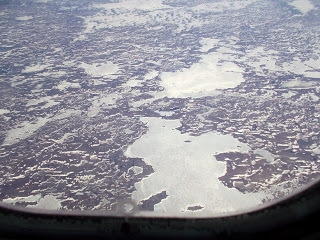 Arctic Tundra from 38,000 feetAfter more than 9 hours of being cooped up in a small space like a battery chicken it was good to be out in daylight again. Compared with other big national airlines, British Airways is definitely no frills - a kind of upmarket Ryan Air. The inflight entertainment system wasn't working properly and the catering was minimal. But I cheered up in the sunny weather and the sight of Haida artist Bill Reid's 'Spirit of Haida Gwaii' sculpture in the centre of Vancouver Airport Arrivals.
Arctic Tundra from 38,000 feetAfter more than 9 hours of being cooped up in a small space like a battery chicken it was good to be out in daylight again. Compared with other big national airlines, British Airways is definitely no frills - a kind of upmarket Ryan Air. The inflight entertainment system wasn't working properly and the catering was minimal. But I cheered up in the sunny weather and the sight of Haida artist Bill Reid's 'Spirit of Haida Gwaii' sculpture in the centre of Vancouver Airport Arrivals.
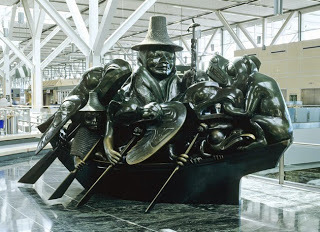
It's one and a half times life-size, cast in bronze with a jade patina and is also called the Jade Canoe. It's difficult to photograph because of the way the light reflects off the bronze. All the main characters of Haida mythology are depicted - Raven steering at the back, the Bear at the front with his human wife and their cubs, Frog, Dogfish Woman, Wolf, Beaver, the Ancient Reluctant Conscript (human) with his high hat, and the tiny Mousewoman peeping from under Raven's wing.
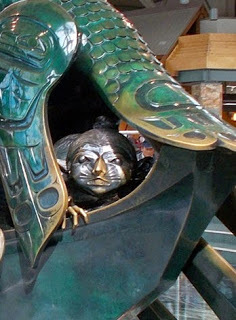
I spent the first night struggling with jet-lag, and eating cornflakes at 4.30am watching ridiculous Canadian TV. It was either ice-hockey or sit-com repeats. I'm staying in a very cheap motel on the outskirts of town, but I have two queen size beds to choose from and the front door opens onto a beautiful courtyard. There's a Macdonalds next door if I get desperate (but I won't!).
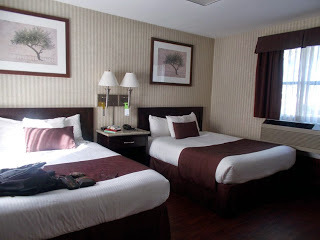
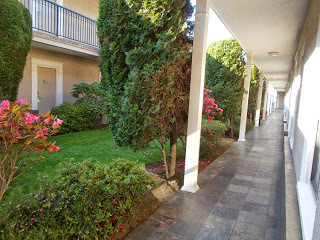
I was lucky enough to find a Chinese supermarket and get supplies for those 4am snack attacks and the odd pot noodle soup for budget evening meals. There are huge numbers of Chinese and Japanese here - all the public signs are in English, French and Japanese. Most of the shops and restaurants seem to be oriental. And the city is vast! But thanks to a very helpful person at the airport I'm equipped with a map and detailed directions. Once I've got the hang of the public transport system (SkyTrain and buses) I'm off to the Anthropological Museum to look at their First Nation collection with high expectations of a treat.
 Arctic Tundra from 38,000 feetAfter more than 9 hours of being cooped up in a small space like a battery chicken it was good to be out in daylight again. Compared with other big national airlines, British Airways is definitely no frills - a kind of upmarket Ryan Air. The inflight entertainment system wasn't working properly and the catering was minimal. But I cheered up in the sunny weather and the sight of Haida artist Bill Reid's 'Spirit of Haida Gwaii' sculpture in the centre of Vancouver Airport Arrivals.
Arctic Tundra from 38,000 feetAfter more than 9 hours of being cooped up in a small space like a battery chicken it was good to be out in daylight again. Compared with other big national airlines, British Airways is definitely no frills - a kind of upmarket Ryan Air. The inflight entertainment system wasn't working properly and the catering was minimal. But I cheered up in the sunny weather and the sight of Haida artist Bill Reid's 'Spirit of Haida Gwaii' sculpture in the centre of Vancouver Airport Arrivals. 
It's one and a half times life-size, cast in bronze with a jade patina and is also called the Jade Canoe. It's difficult to photograph because of the way the light reflects off the bronze. All the main characters of Haida mythology are depicted - Raven steering at the back, the Bear at the front with his human wife and their cubs, Frog, Dogfish Woman, Wolf, Beaver, the Ancient Reluctant Conscript (human) with his high hat, and the tiny Mousewoman peeping from under Raven's wing.

I spent the first night struggling with jet-lag, and eating cornflakes at 4.30am watching ridiculous Canadian TV. It was either ice-hockey or sit-com repeats. I'm staying in a very cheap motel on the outskirts of town, but I have two queen size beds to choose from and the front door opens onto a beautiful courtyard. There's a Macdonalds next door if I get desperate (but I won't!).


I was lucky enough to find a Chinese supermarket and get supplies for those 4am snack attacks and the odd pot noodle soup for budget evening meals. There are huge numbers of Chinese and Japanese here - all the public signs are in English, French and Japanese. Most of the shops and restaurants seem to be oriental. And the city is vast! But thanks to a very helpful person at the airport I'm equipped with a map and detailed directions. Once I've got the hang of the public transport system (SkyTrain and buses) I'm off to the Anthropological Museum to look at their First Nation collection with high expectations of a treat.
Published on May 22, 2015 20:25
May 21, 2015
The Last of England - for a while anyway!
Deep breath . . . here goes . . .

Keep your fingers crossed for me! I'll try and put up some pictures as often as I can.

Keep your fingers crossed for me! I'll try and put up some pictures as often as I can.
Published on May 21, 2015 05:00
May 18, 2015
Tuesday Poem: Inversnaid by Gerard Manley Hopkins
This darksome burn, horseback brown,
His rollrock highroad roaring down,
In coop and in comb the fleece of his foam
Flutes and low to the lake falls home.
A windpuff-bonnet of fawn-froth
Turns and twindles over the broth
Of a pool so pitchblack, fell-frowning,
It rounds and rounds Despair to drowning.
Degged with dew, dappled with dew
Are the groins of the braes that the brook treads through,
Wiry hearthpacks, flitches of fern,
And the beadbonny ash that sits over the burn.
What would the world be, once bereft
Of wet and of wildness? Let them be left,
O let them be left, wildness and wet;
Long live the weeds and the wilderness yet.
Gerard Manley Hopkins (1844 - 1889)
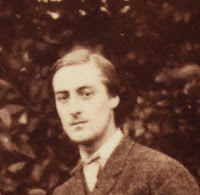
I love Gerard Manley Hopkins' poetry and I thought this one was quite a suitable Tuesday poem for someone about to go out into the wet and the wildness of extreme north west Canada.
One of the things I love about this poem is Hopkins' use of unusual words, some of his own making, but some of them dialect terms. I've been reading Robert McFarlane's book 'Landmarks', about the relationship between language and landscape. Where now do you hear 'degged', 'flitches', 'twindles'? My father used the word 'degged' or 'dagged' when talking about sheep fleeces. 'Braes' and 'burns' are Scottish, but 'fells' are Viking-speak - definitely from my own home territory in Cumbria. The rivers and streams are 'horseback brown' here too at the moment, all roaring down to the sea.
Gerard Manley Hopkins was one of the writers who recorded an account of the 'Krakatoa Sunsets' - the amazing visual effects of the gigantic explosion of the Krakatoa volcano in 1883. It was both poetic and scientifically exact - published in Nature magazine and you can read it here.
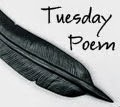 The Tuesday Poets are an international group who all try to post a poem every Tuesday and take it in turns to edit the main website. Why not click on this link and take a look at what the other Tuesday Poets are posting?
The Tuesday Poets are an international group who all try to post a poem every Tuesday and take it in turns to edit the main website. Why not click on this link and take a look at what the other Tuesday Poets are posting?
His rollrock highroad roaring down,
In coop and in comb the fleece of his foam
Flutes and low to the lake falls home.
A windpuff-bonnet of fawn-froth
Turns and twindles over the broth
Of a pool so pitchblack, fell-frowning,
It rounds and rounds Despair to drowning.
Degged with dew, dappled with dew
Are the groins of the braes that the brook treads through,
Wiry hearthpacks, flitches of fern,
And the beadbonny ash that sits over the burn.
What would the world be, once bereft
Of wet and of wildness? Let them be left,
O let them be left, wildness and wet;
Long live the weeds and the wilderness yet.
Gerard Manley Hopkins (1844 - 1889)

I love Gerard Manley Hopkins' poetry and I thought this one was quite a suitable Tuesday poem for someone about to go out into the wet and the wildness of extreme north west Canada.
One of the things I love about this poem is Hopkins' use of unusual words, some of his own making, but some of them dialect terms. I've been reading Robert McFarlane's book 'Landmarks', about the relationship between language and landscape. Where now do you hear 'degged', 'flitches', 'twindles'? My father used the word 'degged' or 'dagged' when talking about sheep fleeces. 'Braes' and 'burns' are Scottish, but 'fells' are Viking-speak - definitely from my own home territory in Cumbria. The rivers and streams are 'horseback brown' here too at the moment, all roaring down to the sea.
Gerard Manley Hopkins was one of the writers who recorded an account of the 'Krakatoa Sunsets' - the amazing visual effects of the gigantic explosion of the Krakatoa volcano in 1883. It was both poetic and scientifically exact - published in Nature magazine and you can read it here.
 The Tuesday Poets are an international group who all try to post a poem every Tuesday and take it in turns to edit the main website. Why not click on this link and take a look at what the other Tuesday Poets are posting?
The Tuesday Poets are an international group who all try to post a poem every Tuesday and take it in turns to edit the main website. Why not click on this link and take a look at what the other Tuesday Poets are posting?
Published on May 18, 2015 15:30
May 17, 2015
Wilderness Wear - madly packing!
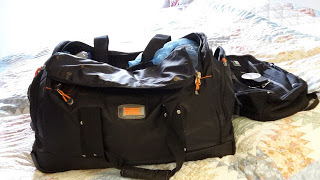
I'm tearing around trying to pack for my flight to north west Canada later in the week. No fancy clothes this time - I'm packing for boats and treks through the forest, encounters with wild animals, sleeping in lodges and changeable weather. So, it's fleeces, t-shirts, waterproof trousers and walking boots. And plenty of blister remedies, insect repellent for the mosquitoes and cream for the inevitable bites. The small planes, and the ferries, ask for duffle bags or back-packs, - no suitcases. I'm trying to travel light, so no room for books - only my trusty Kindle.
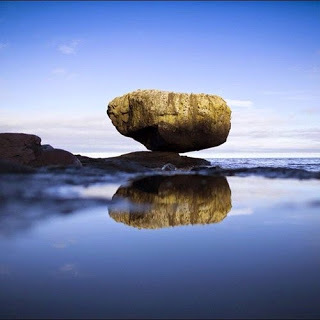 Balance Rock, at Skidegate - one of the places I'm hoping to visit. The itinerary has changed quite a lot. On Wednesday morning I got an email to say that Martin Shaw would not be able to do the workshop next week (my main reason for going!). Fortunately the organisation refunded my accommodation and workshop fees, but I couldn't get the money back on the flights I'd booked. I was gutted at the time - I'd been really looking forward to doing workshops on North American mythology in the landscape the myths relate to. But that isn't going to happen. I'm out on a discovery trip of my own.
Balance Rock, at Skidegate - one of the places I'm hoping to visit. The itinerary has changed quite a lot. On Wednesday morning I got an email to say that Martin Shaw would not be able to do the workshop next week (my main reason for going!). Fortunately the organisation refunded my accommodation and workshop fees, but I couldn't get the money back on the flights I'd booked. I was gutted at the time - I'd been really looking forward to doing workshops on North American mythology in the landscape the myths relate to. But that isn't going to happen. I'm out on a discovery trip of my own.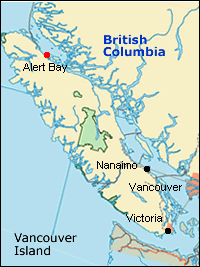
So, I've booked three days in Vancouver (the pink bit on the mainland r. above) to go to the Anthropological museum and some Haida art galleries. And then I'm taking the ferry to Victoria for three days to visit Emily Carr's house and the Museum of British Columbia, allowing myself a few days to wander up to the north end of Vancouver Island - possibly to Alert Bay, where Emily painted the Haida canoes.
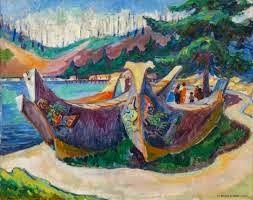
Then I'm back on schedule with a flight to Masset at the northern end of Haida Gwaii, 'on the edge of the world'. The islands are much, much further north than Vancouver Island, which is off the south coast of British Columbia, and I'm going to the northernmost part, more than a thousand miles from Vancouver - almost in Alaska.
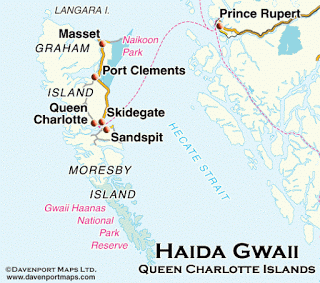
Now, back to the packing and wondering what else I might need!
Published on May 17, 2015 09:28
May 12, 2015
Tuesday Poem: Paeon to Place by Lorine Niedecker
This is an excerpt from Lorine Niedecker's wonderful long poem 'Paeon to Place', which
you can read in full here,
courtesy of the Poetry Foundation.
'. . . I grew in green
slide and slant
of shore and shade
Child-time—wade
thru weeds
Maples to swing from
Pewee-glissando
sublime
slime-
song
Grew riding the river
Books
at home-pier
Shelley could steer
as he read
I was the solitary plover
a pencil
for a wing-bone
From the secret notes
I must tilt
upon the pressure
execute and adjust
In us sea-air rhythm
“We live by the urgent wave
of the verse” . . . '
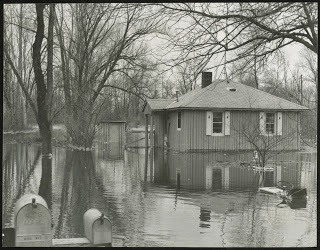 The Niedecker cabin, flooded in 1979. Photo Jim Furley
Lorine Niedecker
was a very unusual poet, living in a cabin on Black Hawk Island, Wisconsin, in the centre of marshland, in almost total seclusion, and is sometimes referred to as 'the Emily Dickinson of the 20th century'. She died in 1970 but her poetry has gained in reputation since her death because of its strong sense of connection between the poet and place, between humanity and the natural world it is part of. There's a good article here about Lorine Niedecker's new status as an 'ecopoet'.
The Niedecker cabin, flooded in 1979. Photo Jim Furley
Lorine Niedecker
was a very unusual poet, living in a cabin on Black Hawk Island, Wisconsin, in the centre of marshland, in almost total seclusion, and is sometimes referred to as 'the Emily Dickinson of the 20th century'. She died in 1970 but her poetry has gained in reputation since her death because of its strong sense of connection between the poet and place, between humanity and the natural world it is part of. There's a good article here about Lorine Niedecker's new status as an 'ecopoet'.
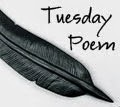 The Tuesday Poets are an international group who try to post a poem every Tuesday and take it in turns to edit the main hub. If you'd like to see what the other Tuesday Poets are posting,
please click on this link
to take you to the main website.
The Tuesday Poets are an international group who try to post a poem every Tuesday and take it in turns to edit the main hub. If you'd like to see what the other Tuesday Poets are posting,
please click on this link
to take you to the main website.
'. . . I grew in green
slide and slant
of shore and shade
Child-time—wade
thru weeds
Maples to swing from
Pewee-glissando
sublime
slime-
song
Grew riding the river
Books
at home-pier
Shelley could steer
as he read
I was the solitary plover
a pencil
for a wing-bone
From the secret notes
I must tilt
upon the pressure
execute and adjust
In us sea-air rhythm
“We live by the urgent wave
of the verse” . . . '
 The Niedecker cabin, flooded in 1979. Photo Jim Furley
Lorine Niedecker
was a very unusual poet, living in a cabin on Black Hawk Island, Wisconsin, in the centre of marshland, in almost total seclusion, and is sometimes referred to as 'the Emily Dickinson of the 20th century'. She died in 1970 but her poetry has gained in reputation since her death because of its strong sense of connection between the poet and place, between humanity and the natural world it is part of. There's a good article here about Lorine Niedecker's new status as an 'ecopoet'.
The Niedecker cabin, flooded in 1979. Photo Jim Furley
Lorine Niedecker
was a very unusual poet, living in a cabin on Black Hawk Island, Wisconsin, in the centre of marshland, in almost total seclusion, and is sometimes referred to as 'the Emily Dickinson of the 20th century'. She died in 1970 but her poetry has gained in reputation since her death because of its strong sense of connection between the poet and place, between humanity and the natural world it is part of. There's a good article here about Lorine Niedecker's new status as an 'ecopoet'. The Tuesday Poets are an international group who try to post a poem every Tuesday and take it in turns to edit the main hub. If you'd like to see what the other Tuesday Poets are posting,
please click on this link
to take you to the main website.
The Tuesday Poets are an international group who try to post a poem every Tuesday and take it in turns to edit the main hub. If you'd like to see what the other Tuesday Poets are posting,
please click on this link
to take you to the main website.
Published on May 12, 2015 08:49
May 9, 2015
Setting off into the unknown
And not just politically. It's been a scary week. As a committed socialist the recent election results have been hard to take. But I've also been focused on a long distance trip. Yes, I'm leaving the country - but only for 3 weeks! And it's one of the scariest trips of my life. I'm heading for the wilderness, more than 1,000 miles north of Vancouver, off the coast of Alaska.
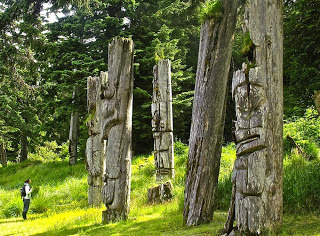 Some of the old Mortuary poles I'm hoping to seeFor the past 3 years I've been working on a new poetry collection, centred round the mythology, and the history, of the Haida people who lived on islands off the Pacific coast of Canada and Alaska for more than 8,000 years (until we arrived). Within a couple of decades of our arrival as colonists their population was reduced from more than twenty thousand to less than five hundred. They have a unique culture - both art and poetry - which I'm hoping to experience at first hand rather than just through books. Like most hunter gatherer societies they had a holistic approach to the environment they lived in and depended upon. They had a saying 'Everything is connected to Everything'. That has a very strong message for us today.
Some of the old Mortuary poles I'm hoping to seeFor the past 3 years I've been working on a new poetry collection, centred round the mythology, and the history, of the Haida people who lived on islands off the Pacific coast of Canada and Alaska for more than 8,000 years (until we arrived). Within a couple of decades of our arrival as colonists their population was reduced from more than twenty thousand to less than five hundred. They have a unique culture - both art and poetry - which I'm hoping to experience at first hand rather than just through books. Like most hunter gatherer societies they had a holistic approach to the environment they lived in and depended upon. They had a saying 'Everything is connected to Everything'. That has a very strong message for us today.
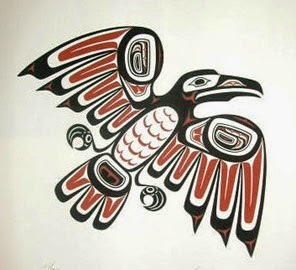 A Haida RavenThe journey is epic - seaplanes, boats and on foot. A nightmare to book over distances online. Every booking I make seems to be dependent on the weather, so nothing is certain. I'll be reporting back whenever I can, via the Blog and Facebook. This documentary trailer gives you an idea of what it's like.
A Haida RavenThe journey is epic - seaplanes, boats and on foot. A nightmare to book over distances online. Every booking I make seems to be dependent on the weather, so nothing is certain. I'll be reporting back whenever I can, via the Blog and Facebook. This documentary trailer gives you an idea of what it's like.
I'm starting off by going to a workshop run by Martin Shaw, on Cortes Island (small seaplane to Campbell River, 2 ferries and a shuttle!) in the south. The workshop is called 'Mythteller'. I'm looking forward to exploring the mythologies of North America with such an expert and hoping that this retreat will help me to finish the collection.
 Some of the old Mortuary poles I'm hoping to seeFor the past 3 years I've been working on a new poetry collection, centred round the mythology, and the history, of the Haida people who lived on islands off the Pacific coast of Canada and Alaska for more than 8,000 years (until we arrived). Within a couple of decades of our arrival as colonists their population was reduced from more than twenty thousand to less than five hundred. They have a unique culture - both art and poetry - which I'm hoping to experience at first hand rather than just through books. Like most hunter gatherer societies they had a holistic approach to the environment they lived in and depended upon. They had a saying 'Everything is connected to Everything'. That has a very strong message for us today.
Some of the old Mortuary poles I'm hoping to seeFor the past 3 years I've been working on a new poetry collection, centred round the mythology, and the history, of the Haida people who lived on islands off the Pacific coast of Canada and Alaska for more than 8,000 years (until we arrived). Within a couple of decades of our arrival as colonists their population was reduced from more than twenty thousand to less than five hundred. They have a unique culture - both art and poetry - which I'm hoping to experience at first hand rather than just through books. Like most hunter gatherer societies they had a holistic approach to the environment they lived in and depended upon. They had a saying 'Everything is connected to Everything'. That has a very strong message for us today. A Haida RavenThe journey is epic - seaplanes, boats and on foot. A nightmare to book over distances online. Every booking I make seems to be dependent on the weather, so nothing is certain. I'll be reporting back whenever I can, via the Blog and Facebook. This documentary trailer gives you an idea of what it's like.
A Haida RavenThe journey is epic - seaplanes, boats and on foot. A nightmare to book over distances online. Every booking I make seems to be dependent on the weather, so nothing is certain. I'll be reporting back whenever I can, via the Blog and Facebook. This documentary trailer gives you an idea of what it's like.I'm starting off by going to a workshop run by Martin Shaw, on Cortes Island (small seaplane to Campbell River, 2 ferries and a shuttle!) in the south. The workshop is called 'Mythteller'. I'm looking forward to exploring the mythologies of North America with such an expert and hoping that this retreat will help me to finish the collection.
Published on May 09, 2015 07:12



